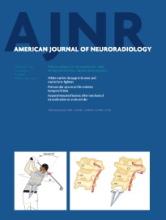Research ArticleBrain
Diffusion Measures Indicate Fight Exposure–Related Damage to Cerebral White Matter in Boxers and Mixed Martial Arts Fighters
W. Shin, S.Y. Mahmoud, K. Sakaie, S.J. Banks, M.J. Lowe, M. Phillips, M.T. Modic and C. Bernick
American Journal of Neuroradiology February 2014, 35 (2) 285-290; DOI: https://doi.org/10.3174/ajnr.A3676
W. Shin
aFrom the Imaging Institute (W.S., S.Y.M., K.S., M.J.L., M.P.)
S.Y. Mahmoud
aFrom the Imaging Institute (W.S., S.Y.M., K.S., M.J.L., M.P.)
K. Sakaie
aFrom the Imaging Institute (W.S., S.Y.M., K.S., M.J.L., M.P.)
S.J. Banks
cLou Ruvo Center for Brain Health (S.J.B., M.T.M.), Cleveland Clinic, Las Vegas, Nevada.
M.J. Lowe
aFrom the Imaging Institute (W.S., S.Y.M., K.S., M.J.L., M.P.)
M. Phillips
aFrom the Imaging Institute (W.S., S.Y.M., K.S., M.J.L., M.P.)
M.T. Modic
cLou Ruvo Center for Brain Health (S.J.B., M.T.M.), Cleveland Clinic, Las Vegas, Nevada.
C. Bernick
bNeurological Institute (C.B.), Cleveland Clinic, Cleveland, Ohio

References
- 1.↵
- Bledsoe GH,
- Li G,
- Levy F
- 2.↵
- Blonstein JL
- 3.↵
- Guterman A,
- Smith RW
- 4.↵
- 5.↵
- Harvey PK,
- Davis JN
- 6.↵
- Saing T,
- Dick MC,
- Nelson PT,
- et al
- 7.↵
- Zhang L,
- Heier LA,
- Zimmerman RD,
- et al
- 8.↵
- Zhang L,
- Ravdin LD,
- Relkin N,
- et al
- 9.↵
- McKee AC,
- Cantu RC,
- Nowinski CJ,
- et al
- 10.↵
- Mendez MF
- 11.↵
- Yuan W,
- Holland SK,
- Schmithorst VJ,
- et al
- 12.↵
- Wu TC,
- Wilde EA,
- Bigler ED,
- et al
- 13.↵
- Sidaros A,
- Engberg AW,
- Sidaros K,
- et al
- 14.↵
- Rutgers DR,
- Toulgoat F,
- Cazejust J,
- et al
- 15.↵
- Matthews PM
- 16.↵
- Xu J,
- Rasmussen IA,
- Lagopoulos J,
- et al
- 17.↵
- Inglese M,
- Makani S,
- Johnson G,
- et al
- 18.↵
- Shanmuganathan K,
- Gullapalli RP,
- Mirvis SE,
- et al
- 19.↵
- Chappell MH,
- Ulug AM,
- Zhang L,
- et al
- 20.↵
- Jezzard P,
- Balaban RS
- 21.↵
- 22.↵
- Basser PJ,
- Mattiello J,
- LeBihan D
- 23.↵
- Basser PJ,
- Pierpaoli C
- 24.↵
- Jenkinson M,
- Smith S
- 25.↵
- Rutgers DR,
- Fillard P,
- Paradot G,
- et al
- 26.↵
- Schaefer PW,
- Huisman TA,
- Sorensen AG,
- et al
- 27.↵
- Wilde EA,
- Chu Z,
- Bigler ED,
- et al
- 28.↵
- Farbota KD,
- Bendlin BB,
- Alexander AL,
- et al
- 29.↵
- Wang JY,
- Bakhadirov K,
- Abdi H,
- et al
- 30.↵
- Kraus MF,
- Susmaras T,
- Caughlin BP,
- et al
- 31.↵
- Cubon VA,
- Putukian M,
- Boyer C,
- et al
- 32.↵
- Zhang K,
- Johnson B,
- Pennell D,
- et al
- 33.↵
- Bazarian JJ,
- Zhong J,
- Blyth B,
- et al
- 34.↵
- Wilde EA,
- McCauley SR,
- Hunter JV,
- et al
- 35.↵
- 36.↵
- Mayer AR,
- Ling J,
- Mannell MV,
- et al
- 37.↵
- Ling JM,
- Pena A,
- Yeo RA,
- et al
- 38.↵
- Wilde EA,
- McCauley SR,
- Barnes A,
- et al
- 39.↵
- Chepuri NB,
- Yen YF,
- Burdette JH,
- et al
- 40.↵
- Pfefferbaum A,
- Sullivan EV
- 41.↵
- Ardekani S,
- Kumar A,
- Bartzokis G,
- et al
- 42.↵
- Giorgio A,
- Santelli L,
- Tomassini V,
- et al
- 43.↵
- Mabbott DJ,
- Noseworthy MD,
- Bouffet E,
- et al
- 44.↵
- 45.↵
- 46.↵
- McCrea M,
- Hammeke T,
- Olsen G,
- et al
In this issue
American Journal of Neuroradiology
Vol. 35, Issue 2
1 Feb 2014
Advertisement
W. Shin, S.Y. Mahmoud, K. Sakaie, S.J. Banks, M.J. Lowe, M. Phillips, M.T. Modic, C. Bernick
Diffusion Measures Indicate Fight Exposure–Related Damage to Cerebral White Matter in Boxers and Mixed Martial Arts Fighters
American Journal of Neuroradiology Feb 2014, 35 (2) 285-290; DOI: 10.3174/ajnr.A3676
0 Responses
Diffusion Measures Indicate Fight Exposure–Related Damage to Cerebral White Matter in Boxers and Mixed Martial Arts Fighters
W. Shin, S.Y. Mahmoud, K. Sakaie, S.J. Banks, M.J. Lowe, M. Phillips, M.T. Modic, C. Bernick
American Journal of Neuroradiology Feb 2014, 35 (2) 285-290; DOI: 10.3174/ajnr.A3676
Jump to section
Related Articles
- No related articles found.
Cited By...
- White matter abnormalities characterise the acute stage of sports-related mild Traumatic Brain Injury
- A common neural signature of brain injury in concussion and subconcussion
- Concussion management in combat sports: consensus statement from the Association of Ringside Physicians
- Prevalence of Traumatic Findings on Routine MRI in a Large Cohort of Professional Fighters
This article has not yet been cited by articles in journals that are participating in Crossref Cited-by Linking.
More in this TOC Section
Similar Articles
Advertisement











